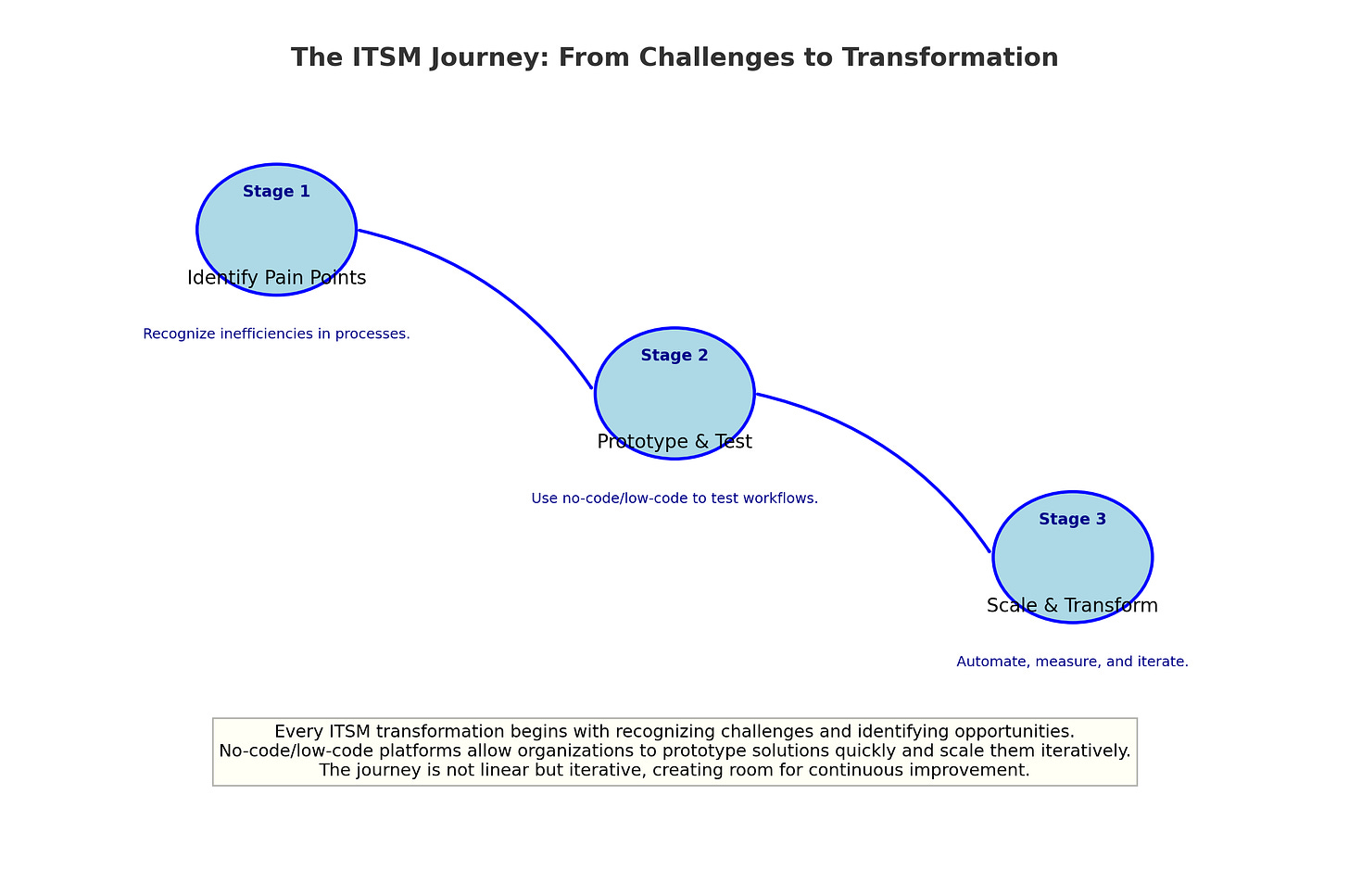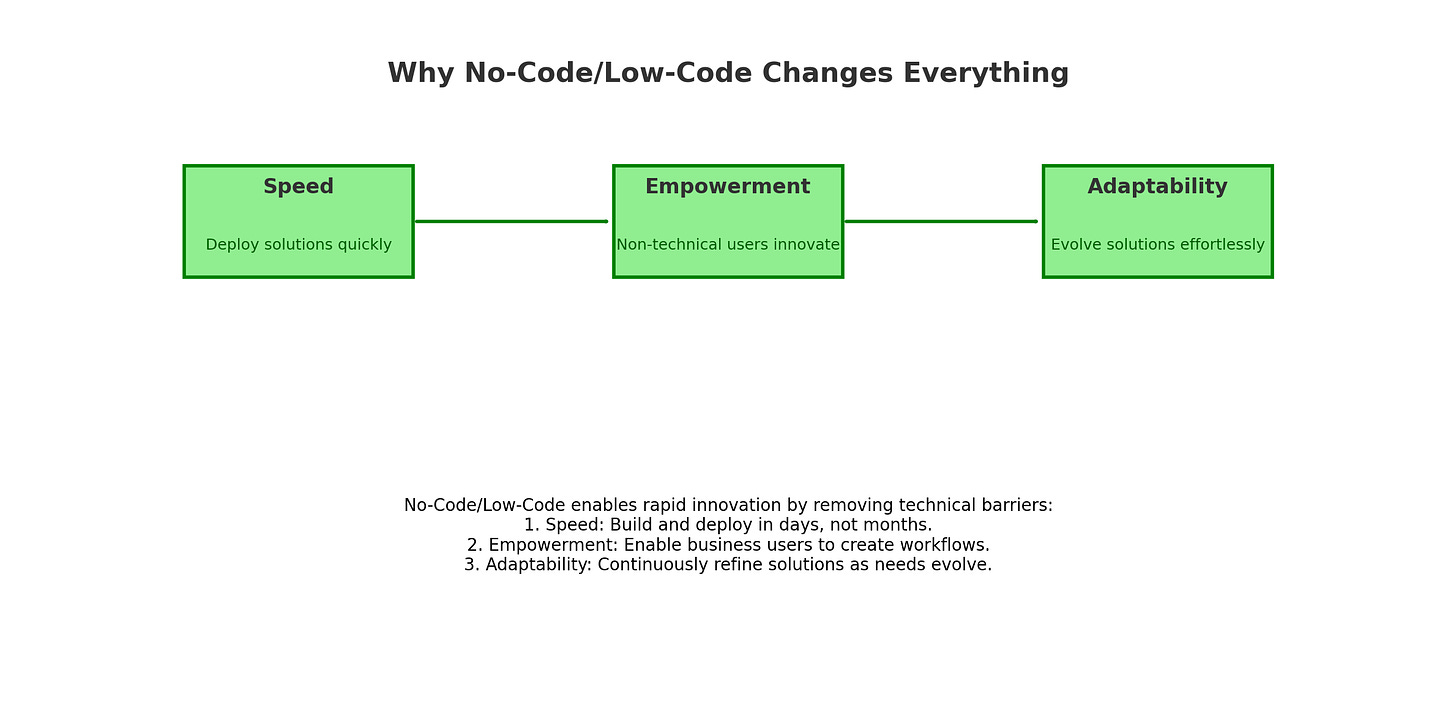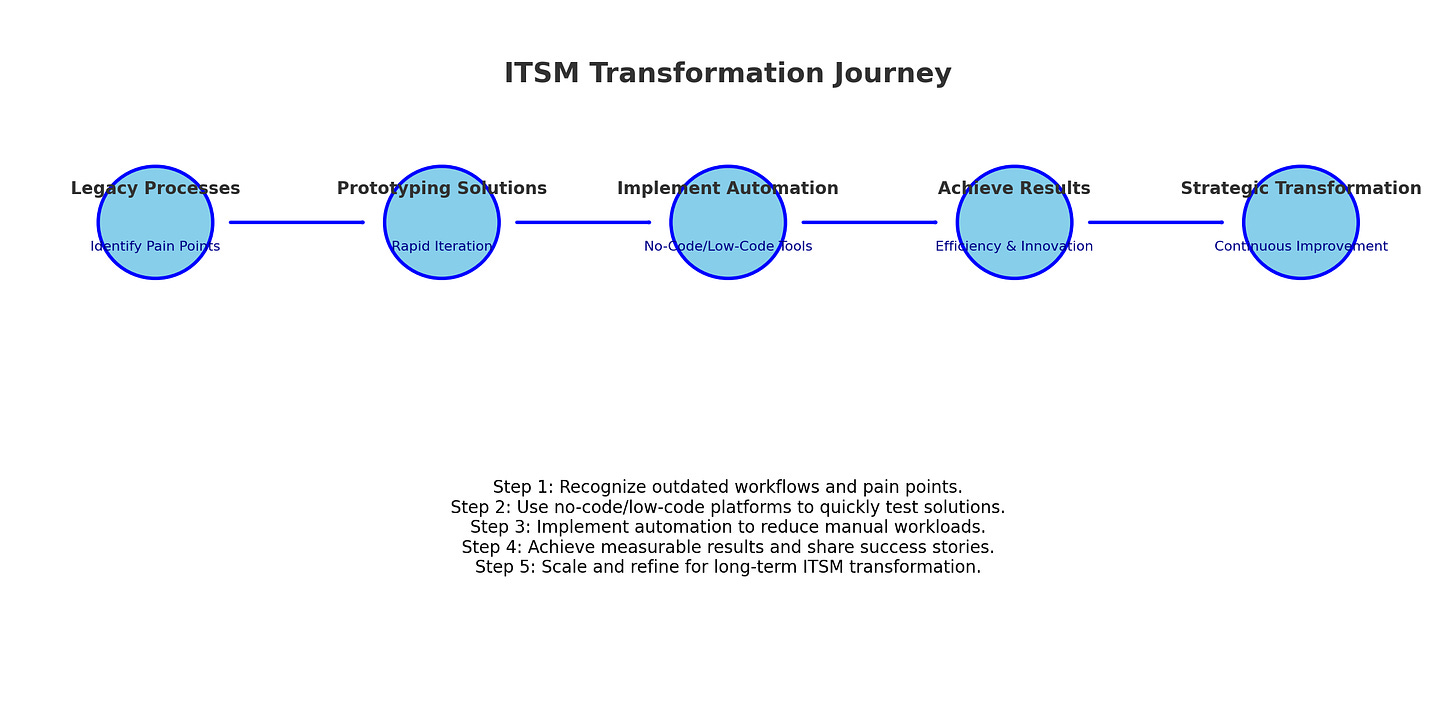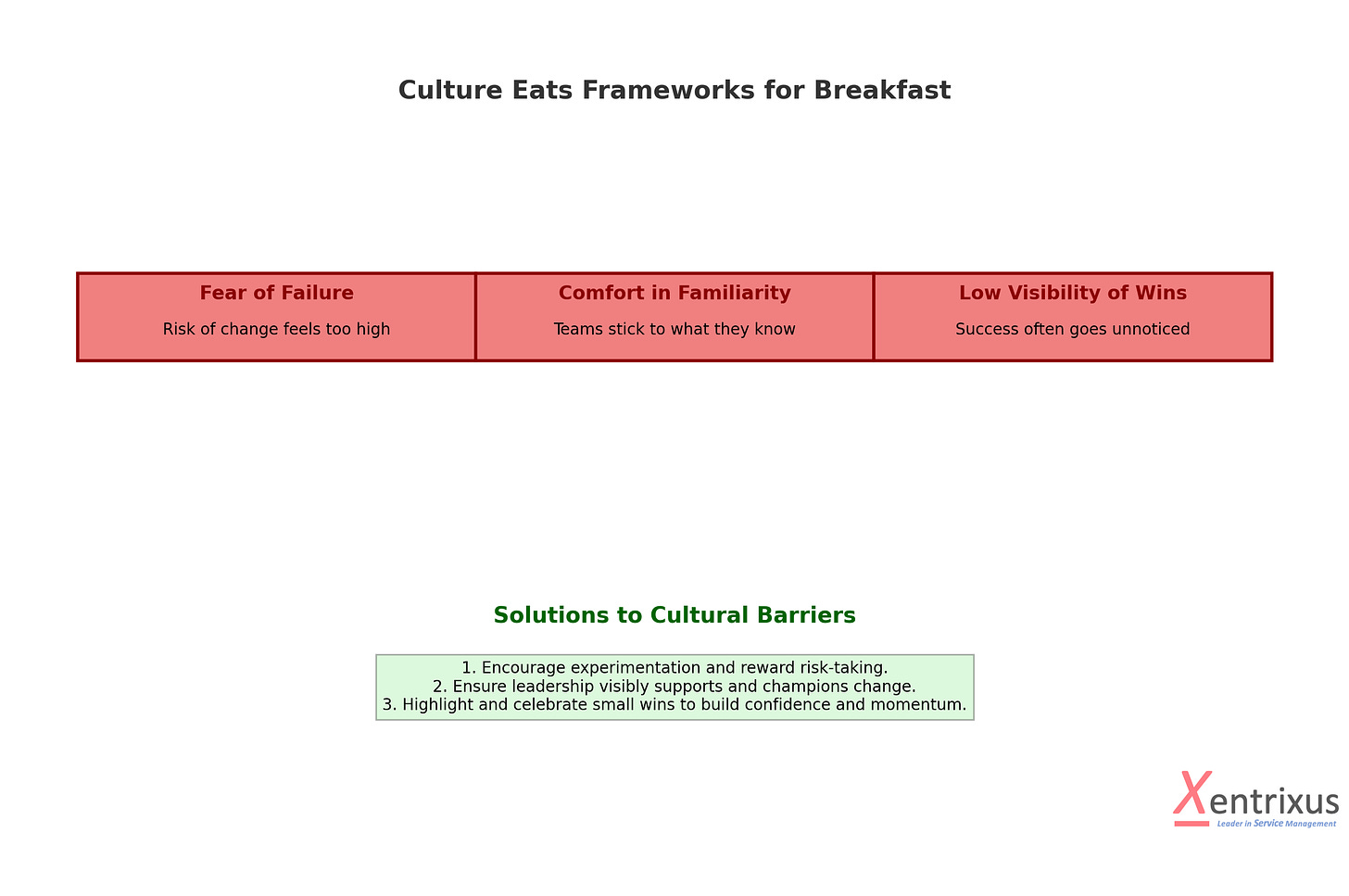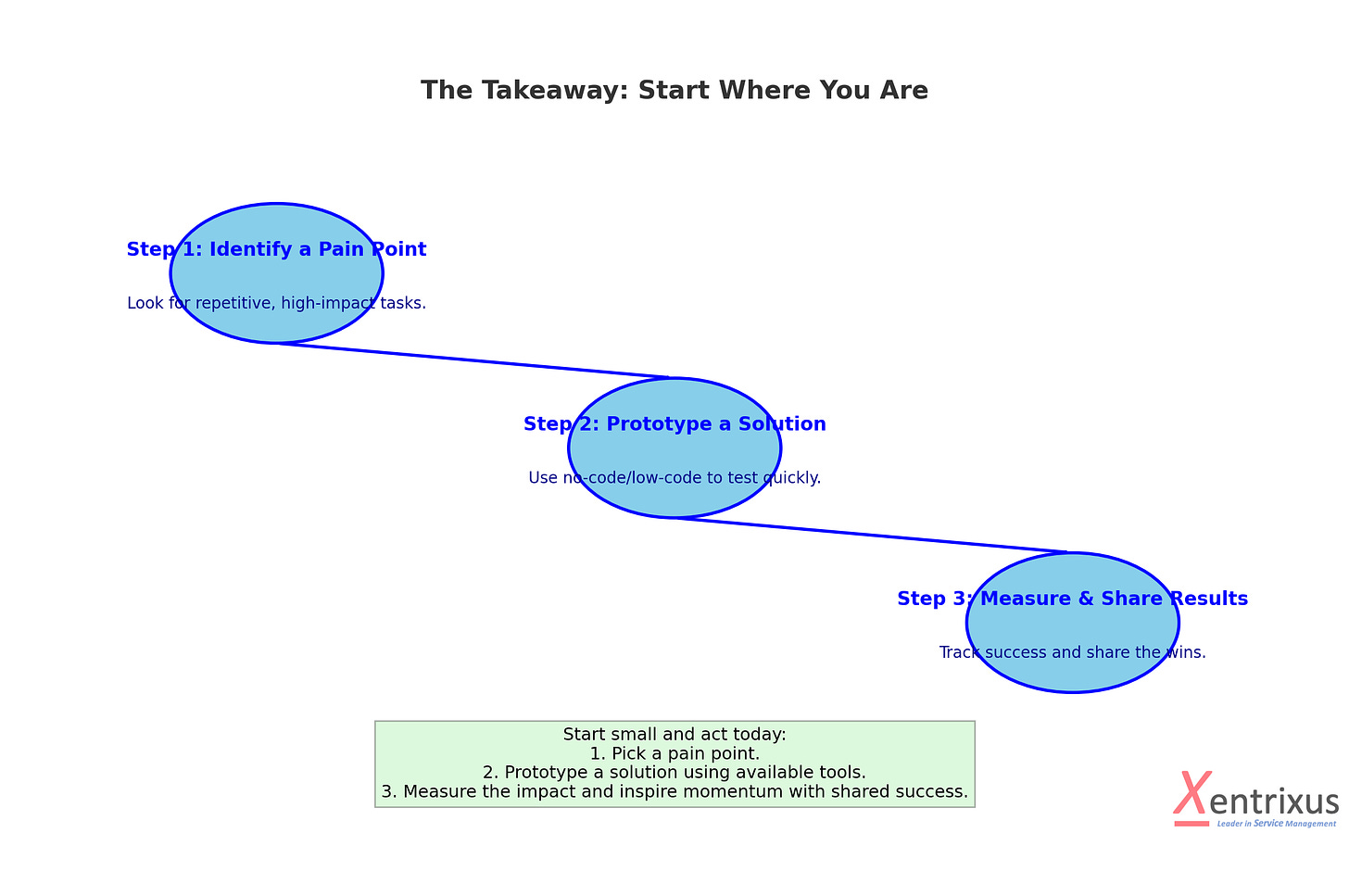How No-Code/Low-Code is Redefining Service Management
From Legacy Overload to Strategic Transformation: A Practical Guide for IT Leaders
The Reality of Legacy ITSM
Let’s be honest. ITSM, as practiced in many organizations, is less of a deliberate strategy and more of an accidental evolution. The workflows weren’t designed—they happened.
Maybe a process was thrown together during a critical outage 15 years ago and never revisited. Maybe a senior leader pushed for a tool implementation without thinking through how it would fit into the broader system. Over time, these stopgaps hardened into the way we’ve always done things.
The symptoms are familiar:
Manual Workload Overload: IT teams spend their days performing repetitive tasks—manually escalating tickets, chasing approvals, or updating users on status changes.
Fragmented Systems: The tools meant to “streamline” IT operations rarely speak to each other, leaving teams stuck toggling between platforms to piece together a solution.
Cultural Stagnation: A sense of “this is just how it is” pervades the organization. Everyone knows things could be better, but the sheer weight of legacy practices makes change feel impossible.
But the thing is that ITSM doesn’t have to feel like this. It wasn’t designed to be a bureaucratic slog or a sinkhole for IT budgets. At its core, ITSM is supposed to be a catalyst—an enabler of agility, efficiency, and business success.
If your ITSM program feels more like an anchor than a sail, the problem isn’t ITSM itself. The problem is how it’s been allowed to drift.
This is where no-code/low-code platforms come in. They offer a way to cut through the inertia, bypassing years of built-up inefficiencies to create workflows that just work.
But before we get there, we need to recognize why traditional ITSM often struggles to evolve:
Fear of Breaking What’s Already Broken: Many IT teams are so overburdened with keeping the lights on that they fear even small changes could lead to outages or chaos.
Siloed Accountability: When no single team owns the end-to-end service delivery, improvements tend to stall out in a sea of competing priorities.
Perceived Complexity of ITIL: Despite its value, ITIL often gets a bad rap as overly prescriptive. For organizations with immature ITSM, the gap between “where we are” and “where we need to be” feels insurmountable.
Recognizing these challenges is the first step. The next? Breaking free from the status quo and showing your teams that better is possible—and achievable.
Why No-Code/Low-Code Changes Everything
Let’s pause and acknowledge something revolutionary ….. we live in a world where creating functional IT workflows no longer requires armies of developers, months of lead time, or bloated budgets. That world is being disrupted by no-code and low-code platforms, and the implications for ITSM are profound.
Think about the typical approach to solving an ITSM problem. You need to automate ticket routing or build a better approval workflow. In a traditional environment, you’d open a project, gather requirements, loop in a development team, and start writing code. Best-case scenario, you’re looking at a solution six months down the road. Worst case? The project stalls, teams lose interest, and the problem festers.
No-code/low-code flips this on its head. These platforms offer drag-and-drop interfaces and pre-built templates that empower IT teams—and even non-technical business users—to design and deploy solutions in days, not months. It’s a paradigm shift:
From dependency to empowerment: Instead of waiting for a development backlog to clear, your teams can take matters into their own hands.
From complexity to simplicity: Need to automate a common request? Map it out visually, configure the logic, and deploy it—all without writing a single line of code.
From stagnation to iteration: Once a workflow is live, tweaks and updates are simple, meaning your processes evolve as your needs change.
But here’s where it gets really exciting: No-code/low-code doesn’t just solve technical problems; it changes how ITSM operates at a fundamental level.
The Strategic Shift
In traditional ITSM, teams often get bogged down by the sheer weight of bureaucracy. Every change feels like a negotiation. Every process improvement requires buy-in from multiple layers of management. With no-code/low-code, you cut through that noise.
These platforms allow organizations to:
Experiment Quickly: Instead of spending weeks debating the “perfect” solution, you can test multiple approaches and see what sticks.
Bridge IT and Business Gaps: Because no-code/low-code is accessible to non-technical users, it creates a collaborative space where IT and business teams can co-create solutions.
Demonstrate Value Faster: When a new workflow is live in a matter of weeks—and visibly improves efficiency—it’s easier to build momentum for broader transformation.
For example, I’ve worked with an organization that was drowning in password reset requests. It wasn’t glamorous, but it was a problem where 40% of their service desk tickets were related to password issues. Using a no-code platform, they deployed a self-service reset tool in under a month. The results were immediate 30% reduction in ticket volume, freeing up the service desk to focus on more complex issues.
That’s the beauty of no-code/low-code. It’s not about overhauling your entire ITSM program overnight—it’s about finding those pain points and solving them, one at a time, with speed and precision.
A Reality Check
Of course, no-code/low-code isn’t a magic bullet. It works best when it’s aligned with a larger vision. Without clarity on what you’re trying to achieve, even the most user-friendly tools can become part of the problem.
This is why no-code/low-code must be integrated thoughtfully:
Pick Your Battles: Not every process needs automation or reinvention. Focus on the areas where you’ll see the most immediate impact.
Create Guardrails: As empowering as these platforms are, they still need oversight to ensure consistency, security, and scalability.
Think Beyond Tools: Remember, no-code/low-code is a means to an end. The real goal is to build an ITSM program that’s more efficient, more adaptable, and more valuable to the business.
When done right, no-code/low-code platforms become more than just tools—they become enablers of cultural change. They shift the conversation from “why is this so hard?” to “what else can we improve?”
Making It Work: A Pragmatic Approach
The idea of transformation is exciting. But when it comes to ITSM, excitement often gives way to skepticism—especially in organizations with deeply ingrained legacy processes. So let’s get practical. How do you actually implement no-code/low-code in a way that creates real value without overwhelming your teams?
The first thing to understand is that this isn’t about overhauling your ITSM program overnight. To be realistic, it’s about taking small, strategic steps that build momentum over time.
Start with the Pain Points
Every IT organization has its “pain points”—those repetitive, time-consuming tasks that frustrate everyone involved. Maybe it’s the never-ending password reset tickets. Maybe it’s the manual routing of incidents to the wrong teams. Maybe it’s a clunky approval process that turns a simple change request into a week-long ordeal.
These pain points aren’t just annoyances; they’re opportunities.
For example, let’s say your service desk spends hours each day handling password reset requests. With a no-code/low-code platform, you can build a self-service reset tool in less time than it takes to write a project proposal.
Users answer a few security questions.
The tool resets their password automatically.
Metrics track usage and flag any anomalies for follow-up.
The result? Your service desk has fewer tickets to manage, and your users experience faster resolutions.
It’s not glamorous, but it’s effective—and it’s the kind of win that builds trust and excitement for what comes next.
Prototype, Don’t Perfect
One of the biggest mistakes organizations make is trying to create a “perfect” solution before launching anything. With no-code/low-code, perfection is the enemy of progress.
Instead of spending weeks—or months—designing a theoretically flawless workflow, aim to build a minimum viable product (MVP). Think of it as a rough draft: it might not be pretty, but it works.
Once the MVP is live, gather feedback:
Are users finding it helpful?
Are there any bottlenecks or edge cases you didn’t anticipate?
What tweaks would make it even better?
The beauty of no-code/low-code platforms is that iteration is easy. You can adjust workflows, add features, and refine the user experience without starting from scratch.
Involve the Right People
No ITSM initiative exists in a vacuum. To make no-code/low-code work, you need to involve stakeholders from across the organization.
IT Teams: These are your power users—the people who know the pain points inside and out. They’ll help you identify where automation can have the greatest impact.
Business Teams: No-code/low-code thrives on collaboration. Bring in non-technical users who can help design workflows that meet real business needs.
Leadership: Visible support from leaders—especially the CTO—creates the buy-in necessary to overcome resistance.
This isn’t just about building workflows; it’s about creating a culture where everyone feels empowered to contribute to better ITSM.
Measure and Share Success
Transformation doesn’t mean much if you can’t show the results. As you implement no-code/low-code solutions, track key metrics:
How much time are you saving?
How many tickets are being resolved faster?
How is user satisfaction changing?
Share these wins widely. When teams see the tangible benefits—fewer repetitive tasks, happier users, and more time for strategic work—they become advocates for continued improvement.
At its core, this approach isn’t just about fixing ITSM processes; it’s about proving that change is possible. And when people see what’s possible, they start to believe in what’s next.
Culture Eats Frameworks for Breakfast
Here’s a hard truth: even the most innovative tools and well-designed workflows will fail if the culture isn’t ready to embrace them. This is why ITSM transformation isn’t just a technical challenge—it’s a cultural one.
In organizations with immature ITSM programs, culture often becomes the biggest barrier to progress. Teams are wary of change, processes feel sacred, and risk aversion stifles innovation. But culture, like workflows, isn’t static. It can be reshaped. And when you introduce no-code/low-code platforms into the mix, they can become catalysts for cultural change.
The Weight of Legacy Thinking
In many organizations, the resistance to ITSM transformation isn’t malicious; it’s practical. Teams are already overworked, firefighting their way through backlogs and outages. The idea of introducing a new tool or approach feels like adding one more burden to an already heavy load.
This resistance often takes the form of:
Fear of Failure: Teams worry that trying something new will make things worse—or expose them to blame.
Comfort in Familiarity: Even if a process is inefficient, people know how it works. Change introduces uncertainty.
Low Visibility of Wins: In many organizations, ITSM successes—like faster ticket resolution or fewer escalations—go unnoticed, while failures are painfully visible.
The result? An ingrained mindset of better the devil you know.
No-code/low-code platforms help shift this narrative because they don’t ask teams to leap into the unknown. Instead, they invite them to experiment, collaborate, and build better solutions together.
Turning Teams into Innovators
The magic of no-code/low-code isn’t just in what it does—it’s in who gets to use it. These platforms don’t require deep technical expertise, which means they open the door for a much broader group of people to participate in ITSM improvements.
Front-Line Empowerment: Service desk agents can design automation for common issues without waiting for a developer’s availability.
Cross-Team Collaboration: Business users and IT teams can co-create workflows, ensuring solutions meet real-world needs.
Iterative Mindset: Because changes are easy to make, teams become more comfortable with experimentation and iteration.
This shift doesn’t just make processes better—it changes how teams see themselves. Instead of being stuck in reactive, firefighting roles, they become proactive problem-solvers.
Leaders Set the Tone
Cultural change starts at the top. For ITSM transformation to succeed, leaders—especially the CTO and senior IT executives—must visibly support the effort.
This means:
Championing Small Wins: Celebrate every improvement, no matter how small. When a new workflow saves two hours a week for the service desk, make it a big deal.
Encouraging Risk-Taking: Make it clear that failure is part of the process. Teams need to know they won’t be penalized for trying something new.
Connecting ITSM to Business Goals: Show how ITSM improvements directly support broader objectives, like customer satisfaction or operational efficiency.
When leadership is actively engaged, it sends a powerful message: ITSM transformation isn’t just an IT initiative—it’s a priority for the entire organization.
The Tipping Point
Culture shifts slowly, but no-code/low-code platforms can accelerate the process. With every successful automation, every faster resolution, and every reduced workload, the old narrative—this is how we’ve always done it—starts to crack.
Over time, a new narrative emerges: one where teams feel empowered to innovate, processes adapt to changing needs, and ITSM becomes a driver of business success rather than a cost center.
But the tipping point doesn’t happen on its own. It requires deliberate effort, consistent leadership, and a willingness to celebrate progress—even the messy, imperfect kind.
The Takeaway: Start Where You Are
Transformation can feel daunting. When you look at your ITSM program and see a tangle of outdated processes, overburdened teams, and clunky tools, it’s easy to feel overwhelmed. Where do you even begin?
The truth is that you don’t need to fix everything at once. In fact, trying to do so is a recipe for frustration. The key to successful ITSM transformation is to start where you are and focus on small, incremental changes that build momentum over time.
Find Your First Win
Every ITSM program has its pain points—those areas where inefficiencies are glaring and the impact is measurable. Start there.
Think about processes that are:
Repetitive: Tasks that consume time but don’t require much judgment or creativity.
High-Volume: Workflows that affect a large number of users or tickets.
Frustrating: Processes that create bottlenecks, delays, or unnecessary friction.
For example, one organization I worked with had a chronic issue with change requests. Their approval process required manual emails to multiple stakeholders, often leading to delays and missed deadlines. Using a no-code/low-code platform, they created an automated workflow that routed requests, tracked approvals, and sent reminders to anyone holding up the process.
The result? Approval times dropped by 60%, and teams could focus on execution rather than chasing signatures.
It wasn’t a comprehensive overhaul of their ITSM program. But it was a win—one that demonstrated the power of automation and built excitement for what came next.
Prototype, Measure, Repeat
Once you’ve identified your first win, approach it like a scientist running an experiment:
Prototype Quickly: Build a simple version of the solution and deploy it. Don’t wait for perfection.
Measure the Impact: Track key metrics, such as time saved, tickets resolved, or user satisfaction scores.
Iterate Based on Feedback: Use insights from the pilot to refine the solution, making it more effective and user-friendly.
This cycle—prototype, measure, repeat—is what turns small wins into sustained progress. It’s also what allows you to adapt to your organization’s unique needs and challenges.
Expand Thoughtfully
As you build momentum, you’ll start to see opportunities to expand your efforts. But it’s important to scale thoughtfully.
Tackle One Area at a Time: Don’t try to automate everything at once. Focus on one process, team, or pain point, and build from there.
Leverage Success Stories: Use early wins to build credibility and support for larger initiatives. When teams see what’s possible, they’re more likely to embrace change.
Involve Stakeholders: Bring in voices from across the organization to ensure your solutions align with business goals and user needs.
Remember, the goal isn’t just to fix individual processes—it’s to create a system that evolves with your business.
Transformation is a Journey
If you take nothing else from this newsletter, let it be this: ITSM transformation is not an overnight project. It’s a journey—a series of deliberate steps that move your organization closer to efficiency, agility, and innovation.
You don’t need to have all the answers today. You don’t need a perfect plan. All you need is the willingness to start, the humility to learn, and the discipline to keep going.
No-code/low-code platforms make that journey easier. They give you the tools to solve problems quickly, iterate often, and build momentum. And as you string together those small wins, you’ll find that the big, systemic changes start to take care of themselves.
So here’s my challenge to you: Identify one process—just one—that’s crying out for improvement. Automate it. Measure the results. Share the story.
And then ask yourself: What’s next?
Your Move
So, what’s your first step? What’s the one process, task, or pain point you’re going to tackle this week?
Take a moment to reflect, and then take action. Because the biggest mistake you can make is waiting for the perfect plan to come along.
And if you need a sounding board, I’m here. Share your thoughts, your challenges, or your wins—I’d love to hear how you’re turning your ITSM struggles into opportunities for growth.
𝘐𝘧 𝘺𝘰𝘶 𝘧𝘰𝘶𝘯𝘥 𝘵𝘩𝘪𝘴 𝘩𝘦𝘭𝘱𝘧𝘶𝘭, 𝘥𝘰𝘯’𝘵 𝘧𝘰𝘳𝘨𝘦𝘵 𝘵𝘰 𝘀𝗵𝗮𝗿𝗲 𝘪𝘵 𝘸𝘪𝘵𝘩 𝘺𝘰𝘶𝘳 𝘯𝘦𝘵𝘸𝘰𝘳𝘬, 𝘀𝘂𝗯𝘀𝗰𝗿𝗶𝗯𝗲 𝘧𝘳𝘦𝘦 𝘵𝘰 𝘨𝘦𝘵 𝘧𝘶𝘵𝘶𝘳𝘦 𝘶𝘱𝘥𝘢𝘵𝘦𝘴, 𝘢𝘯𝘥 𝗰𝗼𝗻𝘀𝗶𝗱𝗲𝗿 𝘀𝘂𝗽𝗽𝗼𝗿𝘁𝗶𝗻𝗴 𝘄𝗶𝘁𝗵 𝗮 𝗽𝗮𝗶𝗱 𝘀𝘂𝗯𝘀𝗰𝗿𝗶𝗽𝘁𝗶𝗼𝗻 𝘪𝘧 𝘺𝘰𝘶 𝘸𝘰𝘶𝘭𝘥 𝘭𝘪𝘬𝘦 𝘵𝘰 𝘨𝘦𝘵 𝘴𝘰𝘮𝘦 𝗲𝘅𝗰𝗹𝘂𝘀𝗶𝘃𝗲 𝗰𝗼𝗻𝘁𝗲𝗻𝘁 𝘭𝘪𝘬𝘦 𝘵𝘩𝘪𝘴 𝘵𝘰 𝘩𝘦𝘭𝘱 𝘮𝘦 𝘬𝘦𝘦𝘱 𝘤𝘳𝘦𝘢𝘵𝘪𝘯𝘨 𝘷𝘢𝘭𝘶𝘢𝘣𝘭𝘦 𝘤𝘰𝘯𝘵𝘦𝘯𝘵.This newsletter is reader-supported, and if you’ve found value in what I’ve shared, I’d love your support. Every subscriber—whether free or paid—gives me the motivation to keep diving deep, researching, and bringing you valuable content that helps you navigate the fast-paced world of Technology.If you’re enjoying this, consider subscribing, or if you already see the value, a paid subscription helps me continue to provide the best possible insights.
Thank you for being part of this community—it truly means the world to me.
Until next time,
𝓦𝓪𝓼𝓮𝓮𝓶
Helping organizations turn IT chaos into business advantage, one step at a time





